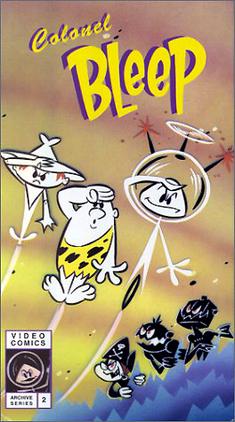Colonel Bleep facts for kids
Quick facts for kids Colonel Bleep |
|
|---|---|

VHS cover art
Top row (L-R): Squeak, Scratch, Colonel Bleep Bottom row (L-R): Black Patch, the Black Knight of Pluto, Bruto the Black Robot |
|
| Genre | Science fiction |
| Created by | Robert D. Buchanan |
| Written by | Robert D. Buchanan |
| Directed by | Jack Schleh |
| Starring | Colonel Bleep Squeek Scratch |
| Narrated by | Noah Tyler |
| Country of origin | United States |
| Original language(s) | English |
| No. of episodes | 100 (44 are known to survive) |
| Production | |
| Running time | 3–6 minutes |
| Production company(s) | Soundac |
| Release | |
| Original network | Syndication |
| Picture format | Color |
| Audio format | Monaural |
| Original release | 1957 – 1960 |
Colonel Bleep is an American animated TV show that first aired in 1957. It was a big deal because it was the very first cartoon series made in color for television! The show was created and written by Robert D. Buchanan and animated by a company called Soundac in Miami.
Colonel Bleep was first shown in 1957 as part of a program called Uncle Bill's TV Club. About 100 episodes were made, and each one was short, lasting between three and six minutes. Today, we know that 44 of these episodes still exist, but eight of them are only available in black and white.
Contents
Meet the Characters and Their Mission
The story of Colonel Bleep begins in 1945, when a huge event on Earth wakes up two important characters. One is Scratch, a caveman who had been sleeping since the Stone Age. The other characters are from a faraway planet called Futura.
The Team Protecting Earth
The people of Futura, who have cool, triangle-shaped heads, send one of their best, Colonel Bleep, to Earth to find out what happened. When Colonel Bleep arrives, he asks Scratch to join him as a helper. Colonel Bleep represents the future, and Scratch represents the past.
A third hero joins them: Squeak. Squeak is a cowboy puppet toy who can move on his own, but he usually can't talk. Together, these three heroes set up a secret base on Zero Zero Island in the Atlantic Ocean. Their mission is to protect Earth and its solar system from bad guys from outer space.
Colonel Bleep's Cool Gear
Colonel Bleep always wears a clear bubble helmet. He also has a helicopter-like propeller and two antennae on his head. The propeller, along with his special unicycle, helps him zoom through space.
His antennae can shoot beams of "futomic energy." This is a special kind of energy that can do many things, often acting like a raygun. Colonel Bleep can only use a certain amount of this energy at a time. Sometimes, he runs out and becomes vulnerable.
Scratch and Squeak's Abilities
Scratch, the caveman, has amazing superhuman strength. He also carries a big club, which he uses to help fight villains. Squeak, the puppet, doesn't have any special powers besides being able to move and think on his own.
Space Age Adventures
The show was very much inspired by the "Space Age" of the 1950s. Sometimes, you would see Colonel Bleep's home planet, Futura. But most of the adventures happened in Earth's solar system. The show imagined that many planets had intelligent life forms. Robots helped with space travel, and a space station called X-1 was a busy hub for transportation.
Types of Episodes and Villains
Colonel Bleep episodes had different kinds of stories. Some were "training episodes" where Scratch would follow Bleep's instructions, but Squeak might get into trouble. Other episodes were like "travel shows," where the trio would visit real places like the Belgian Congo or New Orleans.
Most often, the team would fight against villains from other galaxies. Some of these bad guys appeared many times:
- Dr. Destructo: A hooded supervillain who escaped from the rings of Saturn.
- Bruto the Black Robot: Dr. Destructo's helper.
- Black Patch: A sneaky space pirate.
- The Black Knight of Pluto: A knight from the dwarf planet Pluto.
The Show's History and Legacy
Sadly, most of the original materials from Colonel Bleep's production are now missing. In the early 1970s, the company that made the show, Soundac, was closing down. The director, Jack Schleh, was moving the company's materials in a van when it was stolen. The contents of the van, including the original films, were never found.
Later Releases and Discoveries
Colonel Bleep probably hasn't been shown on TV in the United States since the 1970s. The rights to the show's episodes were not renewed in 1985, meaning they became free for anyone to use.
In 1991, two videocassettes of the series were released by Streamline Pictures. These tapes had most of the episodes that were known to exist at the time. Later, in 2005, Alpha Video released a DVD called Colonel Bleep Volume 1, which included 23 episodes. Many of these had not been seen on earlier video releases.
More recently, some "lost" episodes have been found! In 2019, eight previously lost episodes were uploaded to YouTube. These were found from old black-and-white copies. Another lost episode was found and uploaded to YouTube later that year. These rediscovered episodes came from the personal collection of Ron Kurer.
Influence on Other Shows
One episode, "The Treacherous Pirate," was even included in The Speed Racer Show, a movie released in 1993. This episode appeared between two Speed Racer cartoons.
Also, the creators of the cartoon The Ren & Stimpy Show said that Colonel Bleep was an inspiration for their animators. An episode of Ren & Stimpy called "Space Madness" even includes a scene that looks like Colonel Bleep's opening title sequence!

